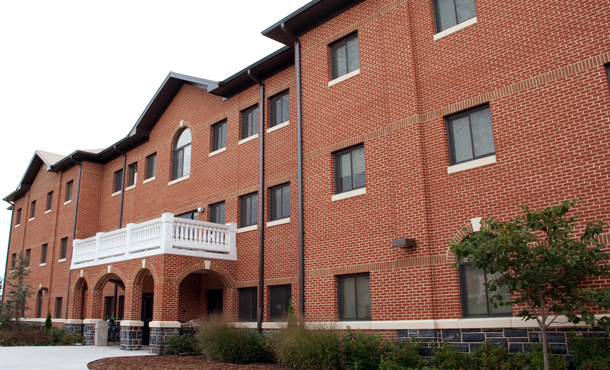Eastern Mennonite University (EMU) remains on the forefront of the “green movement” among U.S. universities, with having the first residence hall in Virginia to attain LEED “gold” certification—one of 33 to achieve this coveted certification in the United States.
A year ago, EMU gained the largest solar deployment in Virginia, with 328 photovoltaic panels installed on the roof of its library. Other “firsts” at EMU on behalf of the environment include: recycling collected by a bicycle-pulled trailer, biofiltration beds to protect a stream that feeds the Chesapeake Bay, and campus landscaping with edible vegetation.
LEED certification for EMU’s new Cedarwood dormitory represents one of the highest environmental standards that construction can reach.
“The gold certification for Cedarwood, along with the pending LEED certifications for the renovated Elmwood and Maplewood residence halls, emphasizes EMU’s strategic plan of sustainability,” said Daryl Bert, vice president for finance at EMU.
The U.S. Green Building Council (USGBC) confers its Leadership in Energy and Environmental Design (LEED) certifications—at the basic, silver, gold or platinum level—on buildings that meet its rigorous standards for environmental sustainability.
Rick Fedrizzi, president, CEO & founding chair of USGBC, praised EMU’s accomplishment: “As the newest member of the LEED family of green buildings, Cedarwood dormitory is an important addition to the growing strength of the green building movement. With each new LEED-certified building, we get one step closer to USGBC’s vision of a sustainable-built environment within a generation.
Cedarwood features
LEED points are awarded for based on the number and type of “green” related systems or designs used in the building process. Cedarwood accumulated 45 points, six more than the minimum ranking for gold.
Cedarwood uses extensive natural lighting; flooring made of recycled and natural materials; a bioretention filtration system to manage rainwater runoff; a bike shed with a “green” landscaped roof; native landscaping around the building itself; and low-flow water fixtures.
Buildings in the United States are responsible for 39 percent of carbon dioxide emissions, 40 percent of energy consumption and 13 percent of water consumption, according to USGBC statistics.
Construction of Cedarwood was made possible through collaboration with several partners—in particular the Troyer Group, long-time architects for EMU based in Mishawaka, Ind., and Harman Construction, Inc., of Harrisonburg. Mast and Brunk Mechanical and Trumbo Electrical contractors, who have been involved in EMU projects since 1991, also played key roles.
The total cost of Cedarwood was $6 million.
“The sustainability emphasis of Cedarwood fits with EMU’s mission, from Micah 6:8, to ‘do justice, love mercy and walk humbly with God,’ with each other and with creation,” said Eldon Kurtz, director of EMU’s physical plant. “It’s a place where students experience community as they prepare to serve and lead in a global context.”
More information on Cedarwood and sustainability at EMU can be found at emu.edu/sustainability/

I am so very proud of my alma mater for its dedication to the environment.
I am active in my own community of Columbia, MD, to support biofiltration of water by having rain gardens, berms, water channels, and rain barrels to keep all rain water on my property and protect the stream behind our house that leads to the Chesapeake Bay. I have also replaced all grass with native plant gardens. Through my garden club I have produced brochures on details of how to achieve water retention and use of organic planting.
Thank you EMU.